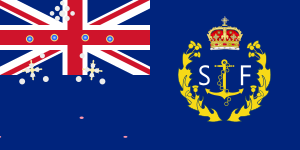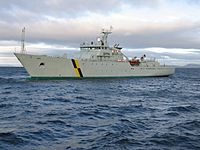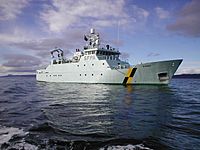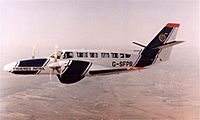Scottish Fisheries Protection Agency facts for kids
| Executive Agency overview | |
|---|---|
| Dissolved | 1 April 2009 |
| Superseding agency |
|
| Jurisdiction | Scotland |
| Headquarters | Edinburgh |
The Scottish Fisheries Protection Agency (SFPA) was a special group that worked for the Scottish Government. Its main job was to protect the seas around Scotland. On April 1, 2009, the SFPA joined with other groups to form Marine Scotland. Marine Scotland is now part of the main Scottish Government.
The SFPA stopped illegal fishing in Scottish waters. It also made sure that the fishing industry in Scotland followed the rules. These rules came from Scotland and the European Union. The SFPA had 18 offices on land. It also had 3 special ships and 2 aircraft. These were used to watch and enforce rules in the waters near Scotland. The letters "SF" on their flag stood for "Sea Fisheries." This showed they were part of the UK Sea Fisheries Inspectorate.
History of Protecting Scottish Fisheries
The Parliament of the United Kingdom started making laws to protect fisheries a long time ago. This began in the early 1800s. Back then, a group called the Commissioners of the British White Herring Fishery was set up. They could use navy ships to watch over herring fishing. Officers were also hired to check and approve cured herring for export.
In 1882, the Fishery Board for Scotland was created. Its job was to protect sea fisheries around Scotland. It also checked catches on land. By 1909, the Board had 5 steam ships. When the Second World War started, they had 8 ships. In 1939, the Board's duties moved to the Secretary of State for Scotland.
SFPA Becomes an Agency
In April 1991, the Scottish Fisheries Protection Agency was officially formed. It became an "executive agency." This meant it was a separate group with its own boss. This boss reported to government ministers. The SFPA started with 230 staff members. It had 20 offices along the coast. It also had 6 protection ships and 2 surveillance aircraft. After Scotland gained more control over its own government, the SFPA moved under the Scottish Executive.
In 2007, the Scottish National Party (SNP) changed how the Scottish Executive worked. The SFPA then became part of the Environment department. In April 2009, the SFPA officially closed down. Its jobs were taken over by the new Marine Scotland.
What the SFPA Did
The SFPA's main job was to make sure fishing rules were followed. They also took action when rules were broken. This helped to stop illegal activities in the sea. They worked to find and stop anyone breaking the law.
How the SFPA Worked
SFPA Headquarters in Edinburgh
The main office of the SFPA was in Pentland House, Edinburgh. This office handled many important tasks. These included money, staff, training, and safety. It also had a special team for legal matters. The Marine Monitoring Centre was also located here.
Marine Monitoring Centre (MMC)
The Marine Monitoring Centre (MMC) decided where SFPA ships and planes should go. They used information to figure out the most important areas to watch. The MMC was also part of the UK Fisheries Monitoring Centre. They watched fishing vessels using a satellite tracking system called VMS. This system tracked all fishing vessels in Scottish waters. It also tracked Scottish vessels around the world. The MMC was open 24 hours a day, every day.
The UK Fisheries Call Centre (UKFCC) was also in the MMC. From June 2005, it was the single place for fishing vessels to report things. This included vessels in UK waters.
SFPA Staff and Teams
The SFPA had 285 staff members. They worked in different areas:
- Marine Surveillance (on ships) – 134 people
- Coastal Inspection (on land) – 124 people
- Headquarters (office staff) – 27 people
Even though the SFPA owned two aircraft, private companies provided the air crews. All SFPA staff were government workers.
Coastal Inspection Team
The Coastal Inspection staff worked on land. They were part of the Sea Fisheries Inspectorate (SFI). They were split into two areas: North/East and South/West. They had offices in many coastal towns.
- FO Eyemouth
- FO Pittenweem
- FO Aberdeen
- FO Peterhead
- FO Fraserburgh
- FO Buckie
- FO Scrabster
- FO Kirkwall
- FO Lerwick
- FO Kinlochbervie
- FO Lochinver
- FO Ullapool
- FO Stornoway
- FO Portree
- FO Mallaig
- FO Oban
- FO Campbeltown
- FO Ayr
The main jobs for the Coastal SFI were to:
- Check catches in ports, on vessels, and in fish markets.
- Weigh fish catches as required by EU laws.
- Make sure fishing logs and landing reports were sent in on time.
- Ensure catches were recorded correctly against fishing limits.
- Investigate if catches were not reported accurately.
- Check registered fish buyers.
- Enforce rules for pelagic fisheries (like herring and mackerel).
Marine Inspection Team
The Marine Sea Fisheries Inspectorate (SFI) used a fleet of 4 Fishery Protection Vessels (FPVs) in 2009. New ships were being built to replace older ones. The SFPA planned to have 3 "Jura" type vessels and 2 "Minna" type vessels.
Scottish FPVs were not military ships. They did not carry weapons. They used the prefix FPV and flew the SFPA's special flag. These ships inspected fishing vessels at sea. They watched Scottish vessels in other countries' waters too. Their presence at sea helped stop illegal fishing. FPVs also helped with international agreements. For example, they patrolled areas for the NEAFC.
Historically, the Royal Navy also provided ships for fishery protection. But in 1994, the SFPA decided they no longer needed this help. From then on, SFPA vessels did all the protection work in Scottish waters.
Jura Type Ships
The Jura-type ships were large offshore patrol vessels. They were 84 meters long. They could stay on patrol for up to 30 days. The first ship of this type was FPV Jura. It was built in Port Glasgow and joined the fleet in March 2006.
An older FPV Jura was built in 1973. It was even used by the Royal Navy for a time.
The Scottish Executive chose a Polish company to build the next two Jura-type ships. This caused some debate. FPV Hirta was built in Poland and launched in August 2007. It joined the fleet in May 2008. Plans for a third ship were put on hold.
Minna Type Ships
The Minna type ships were smaller patrol vessels. They could also stay on patrol for up to 21 days. There was only one ship of this type, FPV Minna. It was built in 2003.
In 2006, plans for a second Minna type ship were delayed. This was because the process did not follow EU rules. A new process started in 2007 but was postponed after the Scottish elections.
The current Minna was the third ship to have this name. It was named after a character in a book by Sir Walter Scott. Previous Minna ships served from 1901–1939 and 1939–1974.
Older Ship Types
The Sulisker type ships were offshore patrol vessels. They could stay on patrol for up to 21 days. The first, FPV Sulisker, was launched in 1980. It was taken out of service in 2006. FPV Vigilant, launched in 1982, was taken out of service in 2008. The last of this type, FPV Norna, was launched in 1987 and stopped service in 2010.
The last of the Island type, FPV Westra, was launched in 1975. It was taken out of service in 2003. This ship was later bought by the Sea Shepherd Conservation Society. It was renamed MY Robert Hunter and then MY Steve Irwin. This ship became well-known from the TV show Whale Wars.
Aerial Surveillance from the Sky
The SFPA also had two surveillance aircraft. Both were Reims Vigilant F-406 planes. They were based at Inverness Airport. A private company operated these aircraft.
The main jobs of the aircraft were to:
- Check the UK VMS system.
- Watch fishing vessels that did not have VMS.
- Patrol sea areas closed to fishing. These areas protected fish or their homes.
- Watch fishing activities in international waters. This helped stop IUU fishing (Illegal, Unreported, and Unregulated).
In 2010, the aircraft were out of service for six weeks due to paperwork problems.
See also
- Marine and Fisheries Agency of England and Wales
- Marine Scotland






